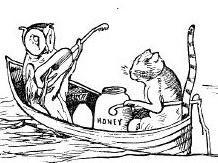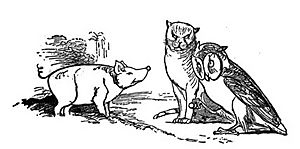The Owl and the Pussy-Cat facts for kids
| by Edward Lear | |

Edward Lear's illustration of the Owl and the Pussycat
|
|
| Illustrator | Edward Lear |
|---|---|
| Country | United Kingdom |
| Meter | or |
| Publication date | 1867 |
| Read online | "The Owl and the Pussy-Cat" at Wikisource |
"The Owl and the Pussy-cat" is a famous nonsense poem written by Edward Lear. It was first shared in 1871 as part of his book Nonsense Songs, Stories, Botany, and Alphabets. Lear wrote this fun poem for a three-year-old girl named Janet Symonds. She was the daughter of his friend, the poet John Addington Symonds. The word "runcible", which you hear in "runcible spoon", was actually made up by Lear just for this poem!
Contents
The Story of the Poem
"The Owl and the Pussy-cat" tells the story of four animals who act like humans. These are an owl, a cat, a pig, and a turkey. The poem is all about the love story between the Owl and the Pussy-cat. They decide to get married in a faraway land "where the Bong-tree grows".
The Owl and the Pussy-cat begin their adventure at sea. They sail away in a bright pea-green boat. They bring along some honey and "plenty of money" in a five-pound note. The Owl sings a sweet song to the Pussy-cat. He looks at the stars and plays his small guitar. The Owl tells the Pussy-cat how beautiful she is.
The Pussy-cat replies by calling the Owl an "elegant fowl". She also tells him how much she loves his singing. The Pussy-cat then suggests that they should get married. But there is one problem: they do not have a wedding ring! So, they sail for a very long time, "a year and a day". They finally reach a land where bong trees grow.
In a wood there, they find a pig with a ring in his nose. They buy the ring from the pig for a small coin called a shilling. The very next day, they are married by a turkey. For their wedding meal, they eat mince and quince. They use a special "runcible spoon" to eat. After their meal, they dance hand-in-hand on the sand. They dance happily in the moonlight.
More Adventures of the Owl and the Pussy-cat
Edward Lear started writing a second part to the poem. It was called "The Children of the Owl and the Pussy-cat". This unfinished story was shared after he passed away in 1938. In this sequel, the children are a mix of bird and cat. They really enjoy eating mice.
The family lives in places with very unusual names. The story mentions that the Cat falls from a tall tree. This means the Owl becomes a single parent. The Owl feels very sad about this. All their money is spent, but the Owl still sings. He sings to the same guitar he had at the start.
The Poem in Books, Music, and Movies
The story of "The Owl and the Pussy-cat" has inspired many other artists. People have made it into books, songs, and cartoons.
- Beatrix Potter, who wrote the Peter Rabbit books, wrote a story before this one. It was called The Tale of Little Pig Robinson. It tells the story of the pig character before he met the Owl and the Pussy-cat.
- Many musicians have set the poem to music.
- Igor Stravinsky created a musical version in 1966.
- Burl Ives also made a musical recording of the poem.
- John Rutter set the words for a choir to sing in 1973.
- Elton Hayes made a popular recording in 1953. It was often played on the radio show Children's Favourites.
- The poem has also been made into cartoons.
- Terrytoons made two animated versions, one in 1934 and another in 1939.
- Weston Woods made a cartoon based on the poem in 1971.
- You can find references to the poem in other famous stories.
- In Explorers on the Moon, a book from The Adventures of Tintin, Captain Haddock sings a line from the poem.
- In Walt Disney's Winnie the Pooh and the Blustery Day, the character Owl mentions a relative who "went to sea in a pea-green boat" with a Pussy-cat.
- Many authors have written new stories based on the poem.
- Eric Idle, from the comedy group Monty Python, wrote a children's book. It is called The Quite Remarkable Adventures of the Owl and the Pussycat. In his story, the pair are attacked by rats.
- In 2013, Julia Donaldson and Charlotte Voake published The Further Adventures of the Owl and the Pussycat. This book is a new sequel to Lear's original poem.
Images for kids




